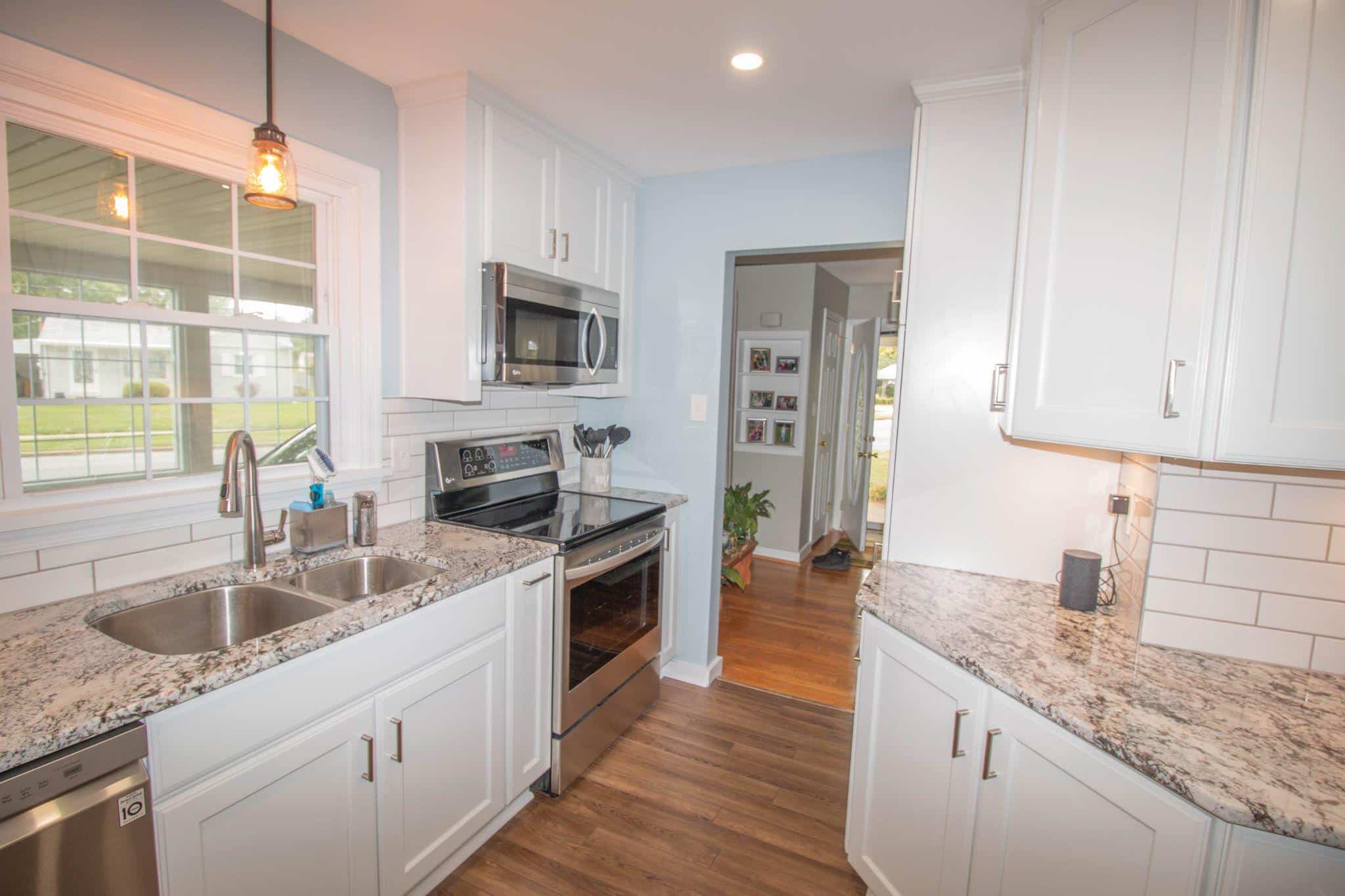Got a headache from poor lighting at home? You’re not alone. Many people struggle with choosing the right light temperature for their spaces.
The difference between warm and cool lighting goes beyond simple color preference – it affects your mood, productivity, and well-being in ways you might not expect.
The right lighting choice can help you sleep better, work more efficiently, and create the perfect atmosphere in each room of your house.
Proper lighting allows you to transform any space into a comfortable environment that suits your needs.
Read on to learn which light temperature works best for different rooms and activities so you can make informed decisions for your home lighting setup.
Understanding Light Temperature
Light color isn’t just about brightness – it’s measured on a Kelvin (K). This scale tells us if the light looks more yellow or blue. Think of it like a thermometer for light color.
The lower numbers on the Kelvin scale, around 2700K to 3000K, create warm light. This type of light gives off soft yellow and orange tints, similar to what you see at sunset.
You’ll notice this warm, cozy glow when you turn on a traditional light bulb.
Higher numbers on the scale, between 4000K and 6000K, produce cool light. This light appears crisp and has blue undertones, much like the midday sun.
Many office buildings use this type of lighting because it closely matches natural daylight.
Here’s a simple breakdown:
- Warm Light (2700K-3000K): Gives off yellow and orange hues, creating a soft, relaxing feel
- Cool Light (4000K-6000K): Shows blue-white tints, offering clear, bright lighting
The difference becomes clear when you put them side by side. Warm light makes colors look more orange, while cool light brings out blues and whites.
Warm Light: Cozy and Inviting
Warm light creates a gentle, soothing glow that helps people feel at home. This yellow-tinted light brings out rich reds, oranges, and browns in your room, making spaces feel more welcoming.
The soft light mimics the natural glow of sunset, creating a calm feeling that puts people at ease. When you use warm light, walls take on a golden hue, and fabrics appear richer in color and texture.
At 2700K to 3000K on the Kelvin scale, warm light makes everyone look their best. It softens facial features and creates a flattering effect that makes skin appear healthy.
This type of lighting reduces shadows and harsh contrasts, which helps minimize eye strain during evening hours.
In social settings, warm light encourages people to stay longer and feel more comfortable. It’s similar to candlelight, creating an atmosphere where conversations flow naturally.
The gentle illumination makes rooms appear smaller and more intimate, perfect for creating cozy spaces where people can unwind.
Benefits of Warm Light:
- It makes skin tones look natural and healthy
- Reduces eye strain in the evening
- Supports your body’s natural sleep cycle
- Creates a calm, peaceful setting
How to Create Comfort with Warm Lights?
Creating a welcoming space starts with smart light placement. Table lamps near seating areas provide focused light for reading or hobbies.
Wall sconces at eye level spread light evenly across the room, filling in shadows. Ceiling fixtures offer overall lighting that ties everything together.
The key is using different light sources at various heights. A mix of floor lamps, table lights, and overhead fixtures creates depth in your room—place lights in corners to soften the edges of your space.
Add small lamps on side tables to make seating areas more inviting. These layers of warm light work together to make any room feel comfortable to unwind and rest.
The goal is to create pockets of light throughout your space. This approach lets you control the brightness for different activities while keeping the warm, relaxing feeling that makes people feel at home.
Cool Light: Bright and Energizing
Cool light matches natural daylight with its blue-white color, rating between 4000K and 6000K on the Kelvin scale. This light keeps your mind sharp by sending signals to your brain that it’s daytime.
The clear, bright output helps you spot small details that might be harder to see with other lighting types.
The human eye picks up blue light waves most easily during daytime hours. Cool light works so well for tasks that need careful attention.
Cool light reduces the strain on your eyes when you’re reading small print, working with tools, or checking important details. It creates less shadow and glare, so you can work longer without feeling tired.
These lights also make whites look whiter and blues look more vivid while keeping other colors true to life. Consider how different things look at noon compared to sunset – cool light brings that same clarity indoors.
For spaces where accuracy matters, this natural-looking light helps you make better decisions about colors and details.
Benefits of Cool Light:
- It makes colors look clear and true
- It helps you stay alert during the day
- Reduces mistakes in detail-oriented tasks
- It makes spaces look clean and fresh
Creating Productive Spaces with Cool Lights
Setting up cool lights in work areas helps build spaces where you can do your best work. The clear light reduces shadows and brightens dark corners, making every task easier to complete.
People often find they can work longer and with better results under this type of lighting. This is why offices, schools, and hospitals choose cool lighting for their spaces.
Warm or Cool Light? Which One is Right for Each Room
1. Living Room
When picking living room lights, warm lights (2700K-3000K) stand out as the better choice. It creates a welcoming feeling that makes people want to stay and chat.
Table lamps and wall fixtures with warm bulbs make skin tones look natural and help everyone feel at ease. While cool light might work for daytime tasks, it can make evening gatherings feel stiff and formal, like sitting in a waiting room.
2. Bedroom
Bedroom lighting needs to support your sleep patterns, making warm light (2700K-3000K) the ideal choice. Soft, yellow-tinted light helps your body prepare for rest by matching your natural evening rhythms.
Cool light, though good for waking up, can trick your brain into staying alert when you should be winding down. Use warm bedside lamps and dimmers to create the right setting for rest.
3. Kitchen
Kitchen tasks need the clarity of cool light (4000K-5000K) for safety and accuracy. It shows food colors truthfully and helps you spot the difference between rare and well-done meat.
Cool light also makes it easier to read small print on recipes and spot any issues with food freshness. While warm light feels nice for dining, it can hide important details when you’re preparing food.
4. Bathroom
Bathrooms benefit from both light types for different times of day. Cool light around mirrors helps you see true colors for makeup and grooming tasks in the morning.
Evening routines work better with warm light that helps you relax. Installing both types with separate controls lets you match the light to your needs throughout the day. This dual setup provides the most useful lighting solution.
5. Home Office
Home offices need cool light (5000K) to create a productive workspace. This lighting reduces glare on screens and keeps you alert during long work sessions.
Task lights at desk level should match overhead fixtures to prevent eye strain. While warm light feels comfortable, it can reduce your energy and focus when you need to concentrate on important work tasks.
6. Study Areas
Study spaces work best with cool light (4000K-5000K) that keeps the mind sharp. Students can focus better and read longer under bright, clear lighting that reduces eye fatigue.
Task lights should sit at the right height to prevent shadows on books and papers. Good lighting design in study areas supports learning by helping maintain attention and reducing mistakes.
Factors to Consider when Choosing Light Temperature
1. Room Purpose and Tasks
Consider what you do in each space. Light needs vary based on activities. Reading needs brighter, clearer light than relaxing. Break down your daily activities in each room.
Kitchens need task lighting for cooking but softer light for eating. Living rooms might need bright light for cleaning but warm light for evening rest.
2. Time and Natural Light
Think about when you use each room most. Morning spaces work well with cool light that matches daylight. Evening rooms need warmer light as the day ends.
Look at your windows and how sunlight moves through your home. Rooms with lots of natural light might need less cool light during the day. Spaces without windows may need stronger cool lights to keep you alert.
3. Personal Comfort and Style
Your comfort matters when choosing lights. Some people work better under cool light, while others prefer warm tones. Test different light types to see what feels right to you.
Look at your room colors and furniture. Warm light brings out browns and reds, while cool light highlights blues and greens. Choose lighting that makes you feel good in your space.
Think about these factors together, not separately. A room might need both types of light for different times and tasks. Adjustable lights or having warm and cool options give you the most flexibility.
Conclusion
Choosing the right light temperature greatly affects how you use and enjoy your spaces. When you match your lighting to each room’s purpose, you create spaces that work better for everyone.
Cool light helps you work and see details clearly, while warm light helps you relax and feel at home.
Remember that light affects more than just how you see – it influences your mood, energy, and daily routines.
By understanding how warm and cool light work together, you can build spaces that support your needs throughout the day.
Small changes in light temperature can turn any room into a space that feels just right, no matter the time or task.
















